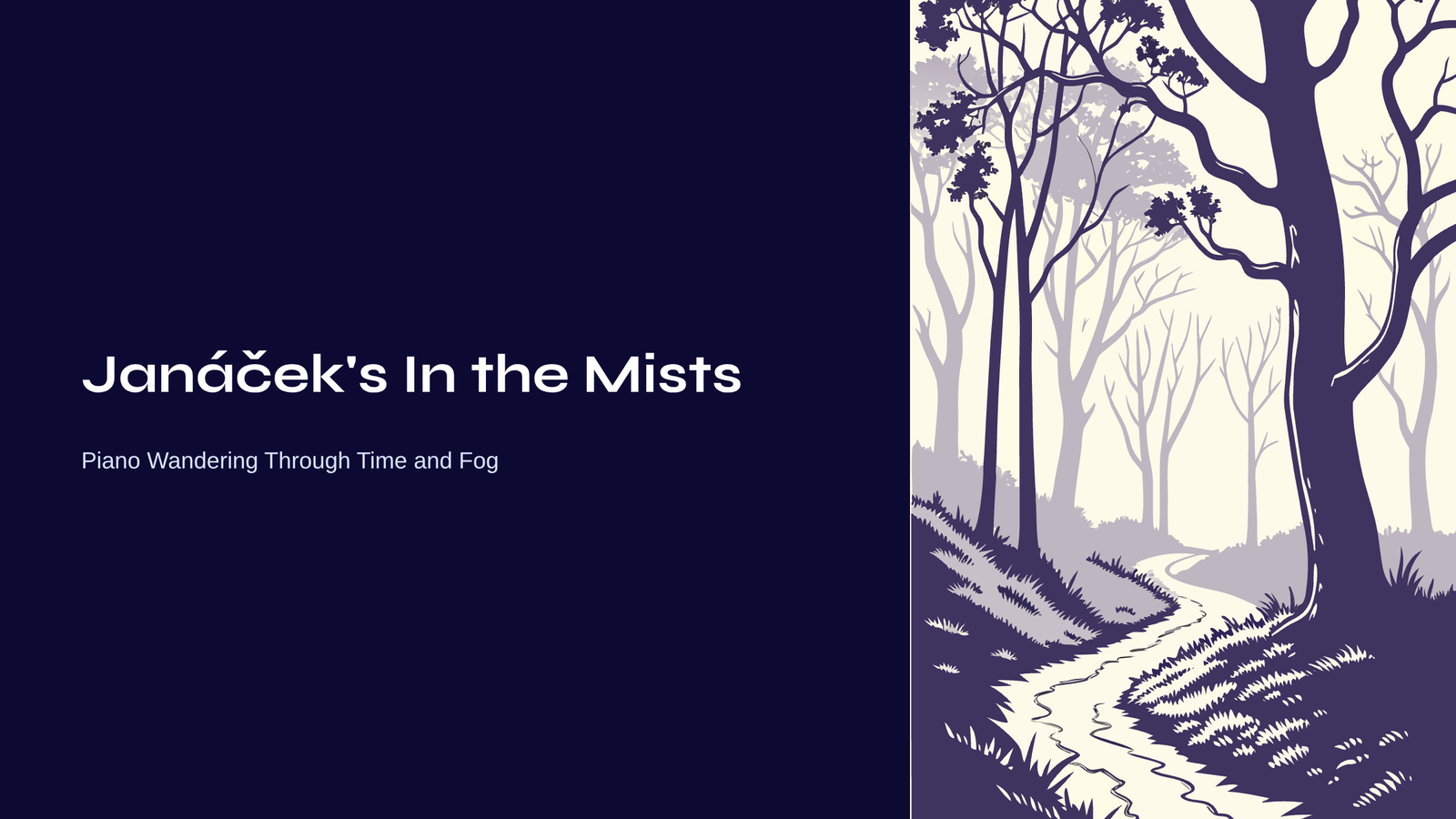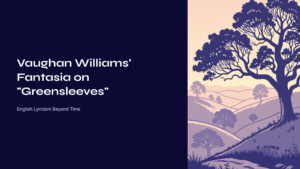Table of Contents
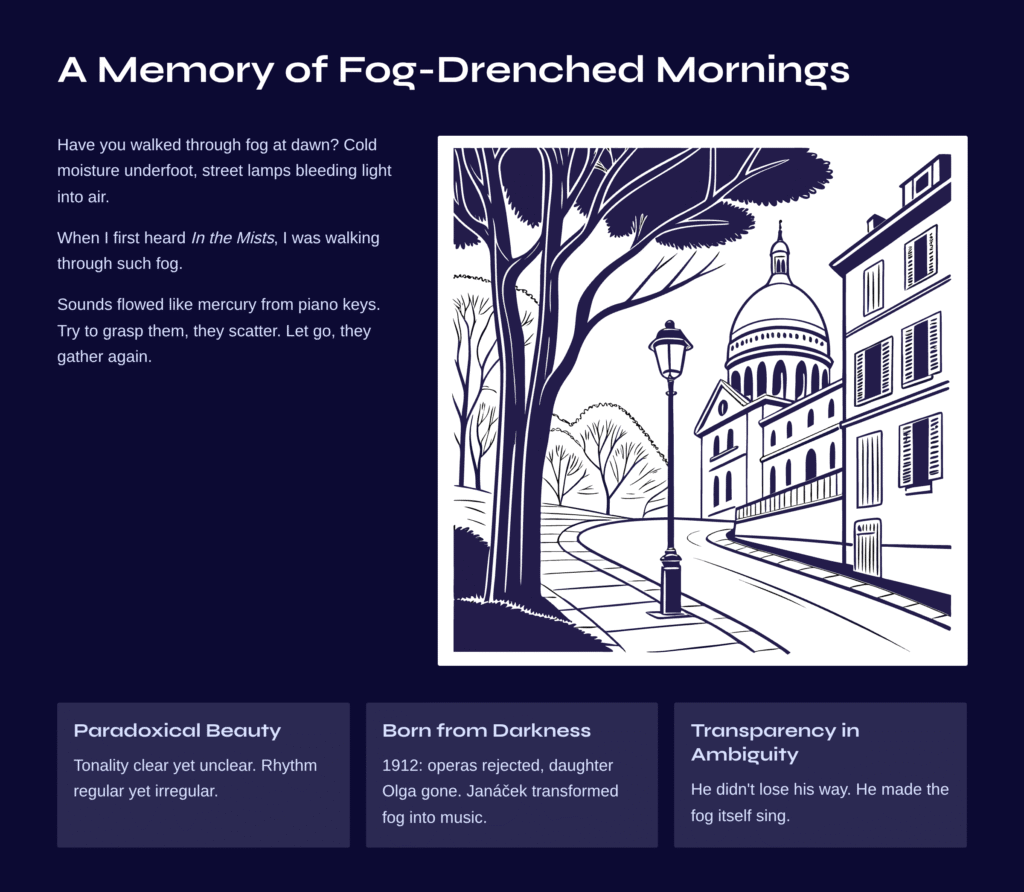
A Memory of Fog-Drenched Mornings
Have you ever walked down a fog-shrouded road at dawn? The cold moisture beneath your feet, the street lamps bleeding their light into the air, the sound of footsteps that may or may not be there. Everything is blurred, yet simultaneously too vivid. When I first heard Janáček’s In the Mists (V mlhách), I was walking through such fog.
The sounds flowing from the piano keys drifted like mercury. When you try to grasp them, they scatter; when you let go, they gather again. The tonality is clear yet unclear, the rhythm regular yet irregular. Before this paradoxical beauty, I could only stand still for a while.
In 1912, when Janáček wrote this piece, his life too was shrouded in fog. His operas were rejected one after another, and his beloved daughter Olga was no longer of this world. Yet he did not lose his way in the fog. Rather, he transformed the fog itself into music. The transparency discovered within ambiguity—that is the essence of In the Mists.
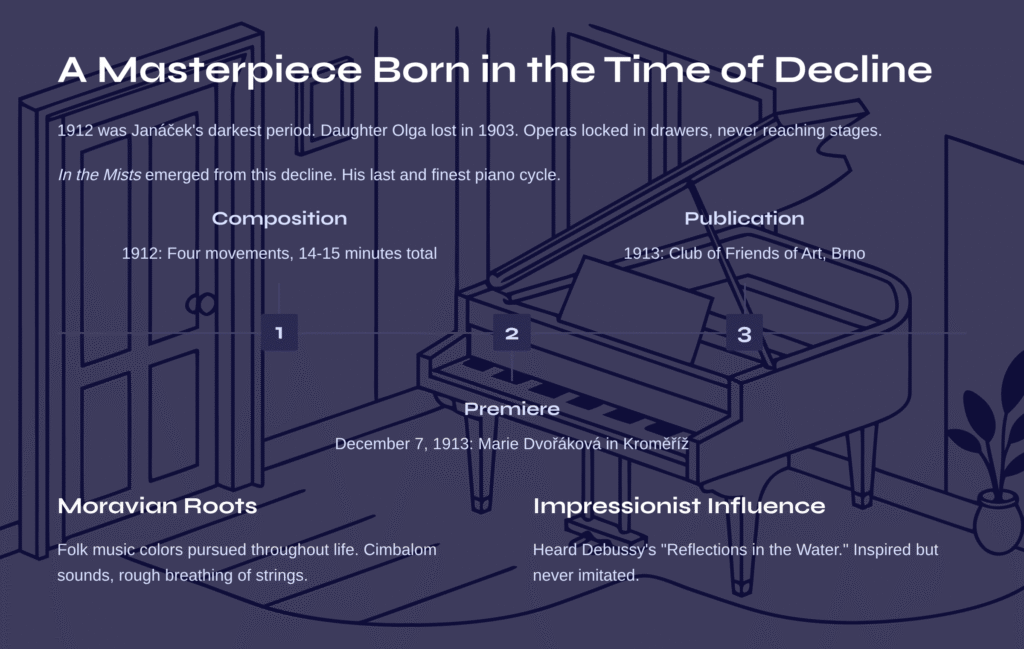
A Masterpiece Born in the Time of Decline
The year 1912, when Leoš Janáček composed In the Mists, was one of the darkest periods of his life. The shadow of losing his daughter Olga in 1903 still weighed heavily on his heart, and the operas he had poured his soul into remained locked in drawers, never reaching the stage. This piano cycle was born precisely from such a period of personal decline.
In the Mists, the last and arguably finest of Janáček’s major piano cycles, consists of four brief movements with a total performance time of approximately 14-15 minutes. It premiered on December 7, 1913, performed by Marie Dvořáková in Kroměříž, and was published the same year by the Club of the Friends of Art in Brno.
What makes this work special is the exquisite fusion of the Moravian folk music colors Janáček pursued throughout his life with the impressionist music then sweeping across Europe. Before the premiere, he heard Debussy’s “Reflets dans l’eau” (Reflections in the Water) and was deeply inspired by its sonic palette. However, Janáček did not simply imitate Debussy. He layered the hazy colors of impressionism with the pattering sounds of the Moravian folk instrument cimbalom, the rough breathing of cellos and violins.
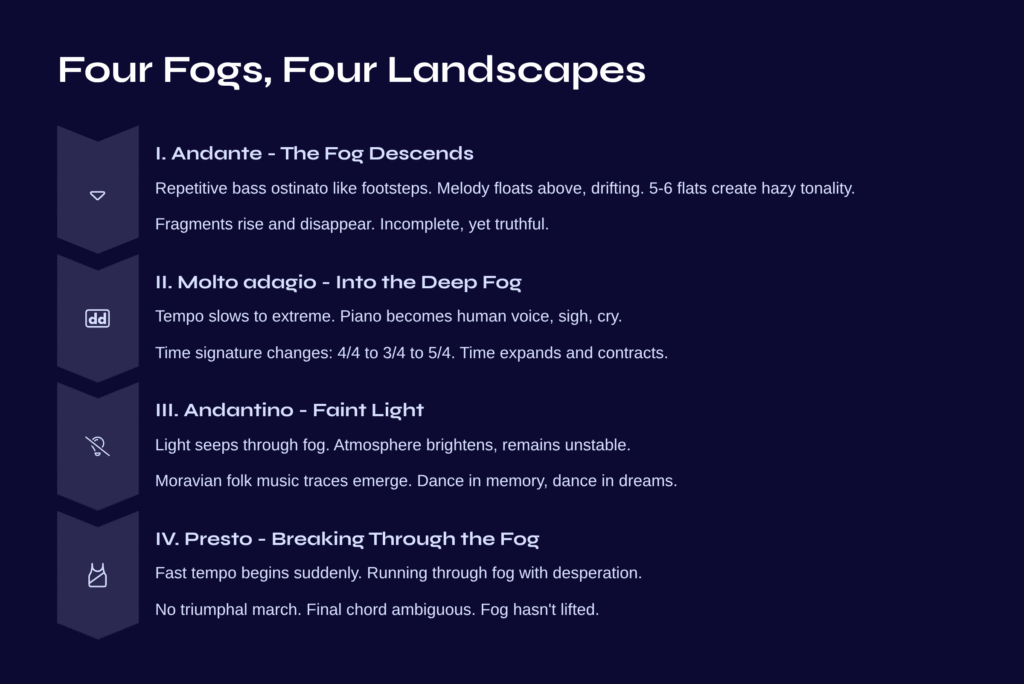
Four Fogs, Four Landscapes
I. Andante – The Fog Descends
The first movement begins quietly yet firmly. The repetitive bass ostinato in the left hand continues steadily, like footsteps walking through fog. But the melody in the right hand floats above it, drifting. The “fog-laden” tonality created by 5-6 flats is neither the major nor minor we’re accustomed to. It exists somewhere in between, a color where gray and silver mingle.
Fragments of melody rise and disappear. Like words that scatter before forming complete sentences. Yet this incompleteness is somehow more truthful. When we try to express sadness, we cannot form complete sentences.
II. Molto adagio – Into the Deep Fog
The second movement leads us to deeper places. The tempo slows to an extreme, and the sound becomes more densely condensed. Here Janáček’s identity as an opera composer emerges. The piano is no longer a piano. It is a human voice, a sigh, a cry bursting from silence.
The time signature changes frequently. From 4/4 to 3/4, then to 5/4. Time does not flow steadily. In sorrow, time expands and contracts repeatedly. In this movement, Janáček translates the elasticity of time into music.
III. Andantino – Faint Light
The third movement is the moment when faint light seeps through the fog. The atmosphere brightens slightly, but remains unstable. The light doesn’t linger long before becoming hazy again. Here the traces of Moravian folk music become more distinct. The rhythm of a dance tune is faintly audible, but it never becomes a complete dance. A dance in memory, a dance in dreams.
The right-hand melody tries to soar lightly like a bird, but the weight of the left hand holds it back. Within the tension between ascent and descent, the music breathes.
IV. Presto – Breaking Through the Fog
The final movement begins suddenly at a fast tempo. The fog is still thick, but now we are running through it. Fingers glide across the keys, notes scattering and gathering like water droplets.
But this is not a triumphal march. There’s a desperation, as if fleeing. From what? Perhaps from sorrow, or from time itself. The movement never provides complete resolution. Even the final chord is ambiguous. The fog has not lifted. We have merely learned how to live within it.
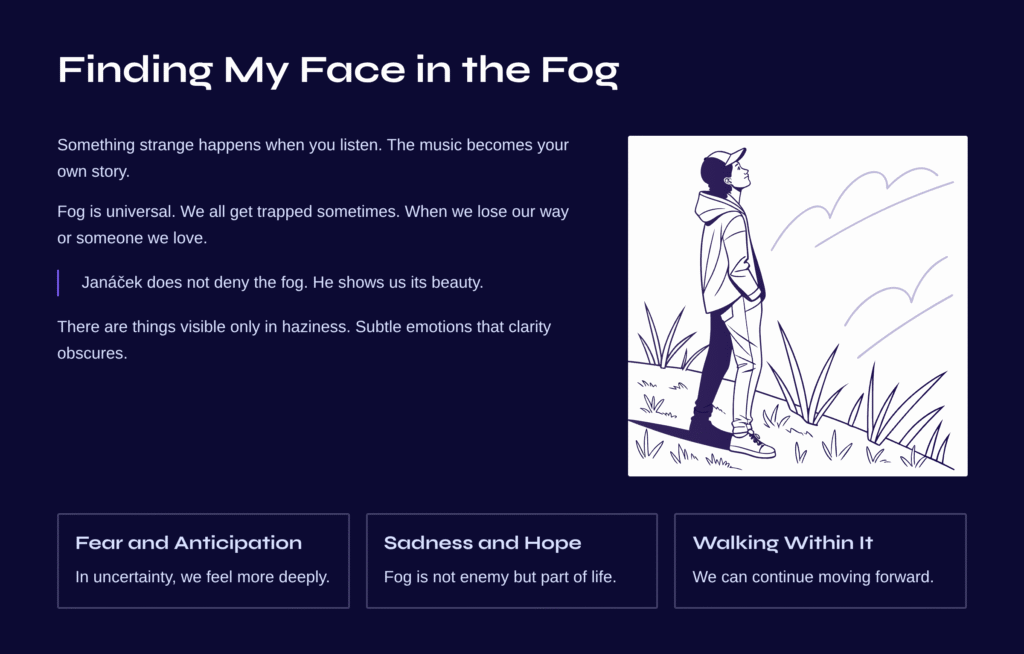
Finding My Face in the Fog
Something strange happens when you listen to In the Mists. The music is clearly Janáček’s, yet at some point it feels like your own story. Because fog is a universal experience. We all get trapped in fog sometimes. When we lose our way, when we lose someone we love, or when our hearts simply cloud over for no reason.
Janáček does not deny the fog. He does not try to forcibly clear it away. Instead, he shows us the beauty of the fog itself. There are things visible only in haziness. Subtle emotions that clarity obscures, inner landscapes that cannot be expressed in definite language.
While listening to this piece, I recalled a moment from several years ago. When I was lost before a major decision. Everything was uncertain, the future as hazy as fog. But in that uncertainty, I actually felt more. Fear and anticipation, sadness and hope. This is what Janáček’s piano speaks of. That fog is not an enemy but part of our lives, that we can continue walking within it.
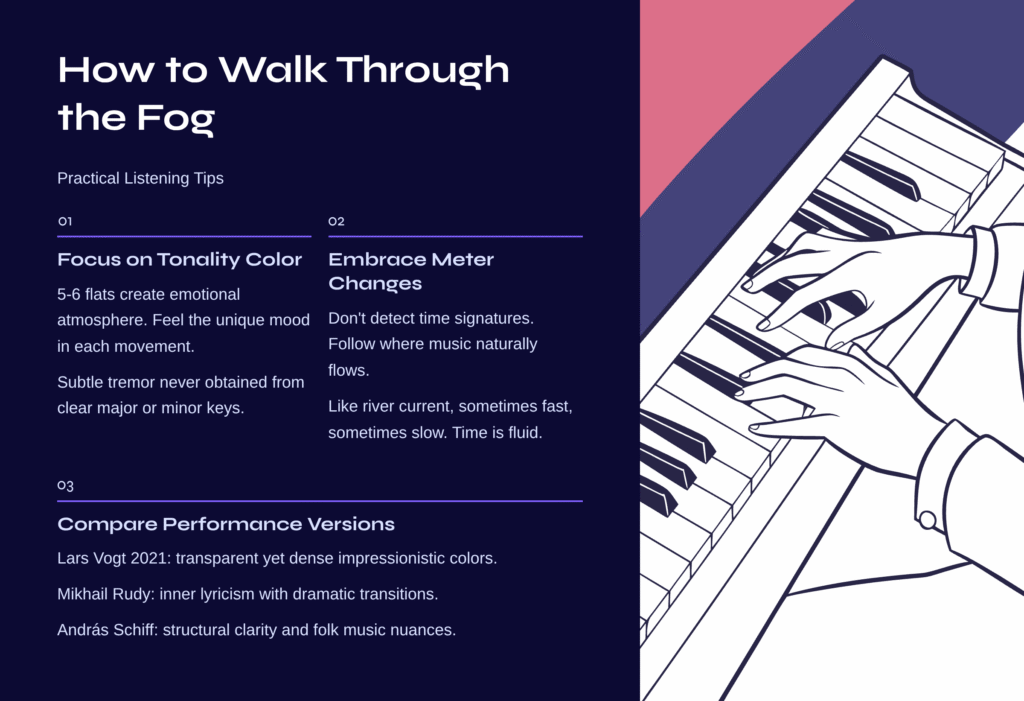
How to Walk Through the Fog – Practical Listening Tips
If you want to experience In the Mists more deeply, I have some suggestions.
First, focus on the color of the tonality. The 5-6 flats Janáček used are not merely a technical choice. They are the color of emotion. As you listen to each movement, feel the unique atmosphere created by these hazy tonalities. There is a subtle tremor of emotion here that can never be obtained from clear major or minor keys.
Second, embrace the changes in meter as freedom rather than constraint. If you listen without looking at the score, don’t try to detect the time signature changes. Instead, follow where the music naturally flows. Like the current of a river, sometimes fast and sometimes slow, time is fluid. Within this fluidity, Janáček captures the truth of human emotion.
Third, compare different performance versions. Lars Vogt’s 2021 recording maximizes impressionistic colors with transparent yet dense sonorities. Mikhail Rudy balances inner lyricism with dramatic transitions, while András Schiff elegantly unfolds structural clarity and folk music nuances. Experiencing how the same score creates different fogs with different performers is itself a journey.
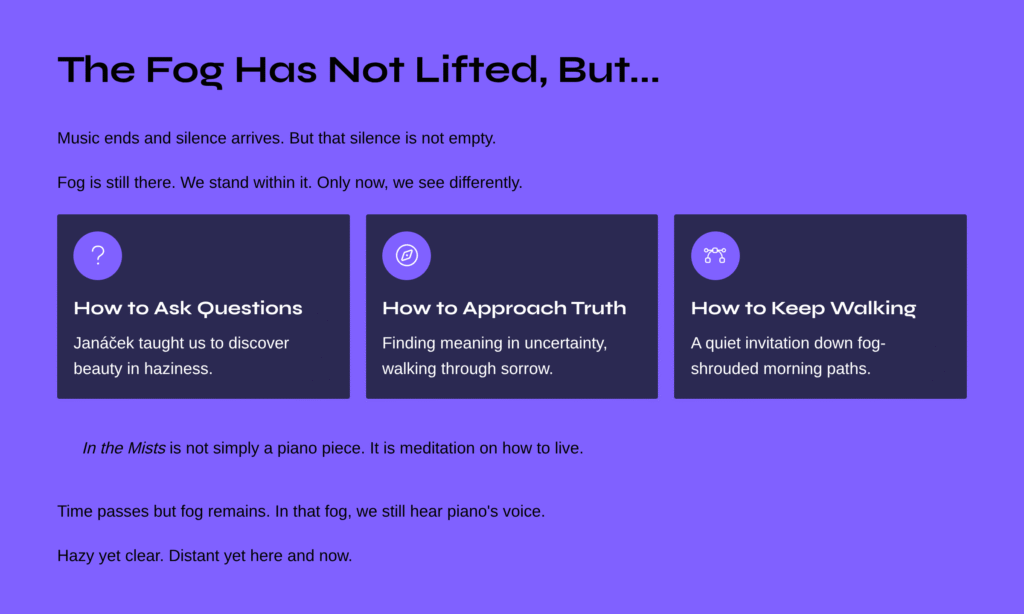
The Fog Has Not Lifted, But…
The music ends and silence arrives. But that silence is not empty. The fog is still there, and we are still standing within it. Only now, we see the fog differently.
Janáček did not give us answers. Instead, he taught us how to ask questions. How to discover beauty in haziness? How to approach truth in uncertainty? How to keep walking in sorrow?
In the Mists is not simply a piano piece. It is a meditation on how to live, a poem about loss and beauty, a quiet invitation to walk together down a fog-shrouded morning path. If you accept this invitation, the fog-bound landscape that Janáček’s piano guides you through will surely resonate with somewhere deep inside you.
Time passes but the fog remains. And in that fog, we still hear the piano’s voice. Hazy yet clear, distant yet here and now—that kind of sound.
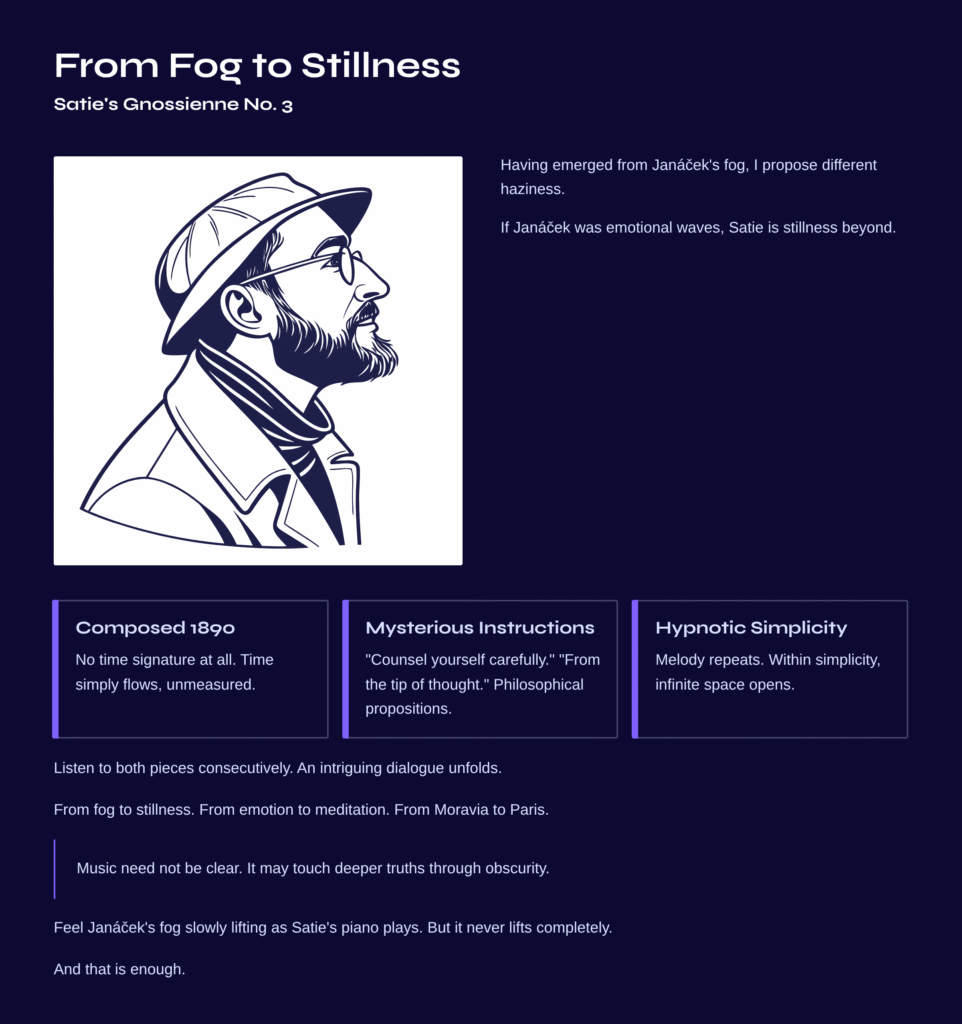
From Fog to Stillness – Satie’s Gnossienne No. 3
Having emerged from Janáček’s fog, I now propose a different kind of haziness. Erik Satie’s Gnossienne No. 3. If Janáček was emotional waves within fog, Satie is the stillness beyond it.
Composed in 1890, this piece has no time signature at all. Time is not measured; it simply flows. Satie left mysterious instructions in the score: “Counsel yourself carefully” (Conseil léger sur soi-même), “From the tip of thought” (Du bout de la pensée). These are not musical directions but philosophical propositions.
The melody of Gnossienne No. 3 is simple. It repeats almost hypnotically. Yet within that simplicity, infinite space opens. If Janáček found emotion in fog, Satie finds existence in stillness. Both composers rejected clarity and chose ambiguity, but they arrived at different places.
If you listen to these two pieces consecutively, an intriguing dialogue unfolds. From fog to stillness, from emotion to meditation, from Moravia to Paris. Yet they all speak the same truth—that music need not be clear, and indeed may touch deeper truths through obscurity.
As you listen to Satie’s piano, feel Janáček’s fog slowly lifting. But it will never lift completely. And that is enough.
Recommended Recordings and Listening Guide:
– Janáček In the Mists: Lars Vogt (2021), Mikhail Rudy, András Schiff
– Satie Gnossienne No. 3: Alexandre Tharaud, Aldo Ciccolini, Jean-Yves Thibaudet
– Comparative Listening: Debussy “Reflets dans l’eau”, Janáček “On an Overgrown Path”
